Papers by Carlo S Regazzoni
International Journal of Human-computer Studies / International Journal of Man-machine Studies, 2017
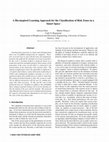
Learning from experience is a basic task of human brain that is not yet fulfilled satisfactorily ... more Learning from experience is a basic task of human brain that is not yet fulfilled satisfactorily by computers. Therefore, in recent years to cope with this issue, bio-inspired approaches has gathered the attention of several researchers. In this work a learning method is proposed based on a model derived from neurophysiological observations of the generation of the sense of self which is connected to the memorization of the interaction with external entity. The domain of application where this algorithm is employed, is a Cognitive Surveillance system which aims at detecting intruders and communicate guidance messages to a user (a guard) provided with a mobile device in order to chase him. The proposed method intends to allow the system to establish an efficient interaction with the user by sending messages only when necessary. To this end the zones of the monitored area are classified according to the probability that a change in pursuit strategy will occur by learning online the motion of the user and the intruder. The proposed algorithm has been tested on real world data demonstrating the capacity of learning this information to be used to tag the zones of the area under exam.
NSIP, 1999
Monitoring systems of outdoor environments for surveillance applications need real time solutions... more Monitoring systems of outdoor environments for surveillance applications need real time solutions for complex computer vision problems. However, advanced visual surveillance systems not only need to detect and track moving objects but also to interpret their pattern of behaviour. This work aims at presenting a method based on the use of neural networks for classification of moving tracked objects. Application scenario consists of an entrance access of a touristic village crossed by vehicles and the main aim of the method is to recognise possible presence of pedestrians in the zone.
Annales Des Télécommunications, Sep 1, 1990
Abstract In this paper, we present a new approach to picture coding that integrates, in an intel... more Abstract In this paper, we present a new approach to picture coding that integrates, in an intelligent way, some advanced techniques. The basic idea is to code by different methods the areas in a scene that are characterized by different degrees of importance. To this end, we use an understanding system that locates such areas and applies to them either vector
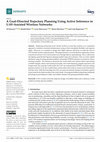
Deploying UAVs as aerial base stations is an exceptional approach to reinforce terrestrial infras... more Deploying UAVs as aerial base stations is an exceptional approach to reinforce terrestrial infrastructure owing to their remarkable flexibility and superior agility. However, it is essential to design their flight trajectory effectively to make the most of UAV-assisted wireless communications. This paper presents a novel method for improving wireless connectivity between UAVs and terrestrial users through effective path planning. This is achieved by developing a goal-directed trajectory planning method using active inference. First, we create a global dictionary using TSPWP instances executed on various training examples. This dictionary contains letters representing available hotspots, tokens representing local paths, and words depicting complete trajectories and hotspot order. By using this world model, the UAV can understand the TSPWP’s decision-making grammar and how to use the available letters to form tokens and words at various levels of abstraction and time scales. With this...
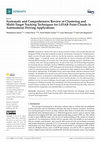
Sensors
Autonomous vehicles (AVs) rely on advanced sensory systems, such as Light Detection and Ranging (... more Autonomous vehicles (AVs) rely on advanced sensory systems, such as Light Detection and Ranging (LiDAR), to function seamlessly in intricate and dynamic environments. LiDAR produces highly accurate 3D point clouds, which are vital for the detection, classification, and tracking of multiple targets. A systematic review and classification of various clustering and Multi-Target Tracking (MTT) techniques are necessary due to the inherent challenges posed by LiDAR data, such as density, noise, and varying sampling rates. As part of this study, the Preferred Reporting Items for Systematic Reviews and Meta-Analyses (PRISMA) methodology was employed to examine the challenges and advancements in MTT techniques and clustering for LiDAR point clouds within the context of autonomous driving. Searches were conducted in major databases such as IEEE Xplore, ScienceDirect, SpringerLink, ACM Digital Library, and Google Scholar, utilizing customized search strategies. We identified and critically rev...
IEEE Transactions on Intelligent Transportation Systems
IEEE Transactions on Vehicular Technology
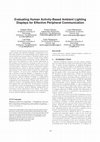
Proceedings of the 11th International Conference on Body Area Networks, 2017
Ambient Assisted Living (AAL) applications leverage pervasive sensing and ambient intelligence te... more Ambient Assisted Living (AAL) applications leverage pervasive sensing and ambient intelligence technologies to enable older people to live independently and to support their social inclusion and connectedness. Wearable sensors can be used to gather the elderly's activities of daily living (ADLs) data, thus enabling remote monitoring. Lately, ambient displays have been deployed to relay activity information in the periphery of the caregivers' attention in order to increase awareness of the activities of the elderly and to create a sense of connectedness. Moreover, there is accumulated evidence demonstrating the ability of ambient displays to influence and promote social connectedness between the elderly and their caregivers. In recent years, intelligent ambient lighting, a subclass of ambient displays, is emerging as an effective tool for conveying physical activity information. Existing literature suggests lighting encodings or configurations combining color, rate of change, position and brightness to communicate such information. Within AAL, there is little empirical evidence surrounding ambient lighting encodings that support this cause effectively. In this paper, we present an exploratory study investigating how potential caregivers perceive and interpret ambient lighting configurations for presenting activity information of the elderly. User preference, change noticeability and accuracy of the interpretation of three ambient lighting configurations were evaluated.
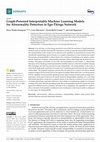
Sensors, 2022
In recent days, it is becoming essential to ensure that the outcomes of signal processing methods... more In recent days, it is becoming essential to ensure that the outcomes of signal processing methods based on machine learning (ML) data-driven models can provide interpretable predictions. The interpretability of ML models can be defined as the capability to understand the reasons that contributed to generating a given outcome in a complex autonomous or semi-autonomous system. The necessity of interpretability is often related to the evaluation of performances in complex systems and the acceptance of agents’ automatization processes where critical high-risk decisions have to be taken. This paper concentrates on one of the core functionality of such systems, i.e., abnormality detection, and on choosing a model representation modality based on a data-driven machine learning (ML) technique such that the outcomes become interpretable. The interpretability in this work is achieved through graph matching of semantic level vocabulary generated from the data and their relationships. The propo...
Publication in the conference proceedings of EUSIPCO, Toulouse, France, 2002
Publication in the conference proceedings of EUSIPCO, Toulouse, France, 2002
1996 8th European Signal Processing Conference (EUSIPCO 1996), 1996
In this paper, a Markov Random Field (MRF)-based method is presented. MRF methods are based on a ... more In this paper, a Markov Random Field (MRF)-based method is presented. MRF methods are based on a probabilistic representation of a image processing problem; the problem is represented as the maximization of a probability measure computed starting from input data for all possible solutions. The optimization process is often computationally expensive. The coupled problem of restoring and extracting edges from an image is here considered. An extension to the color case of the deterministic mean-field annealing method presented in [1] is presented. The main advantage of this approach is its capability of obtaining a sub-optimum solution in a faster way with respect to optimal stochastic methods (e.g., Simulated Annealing).
2000 10th European Signal Processing Conference, 2000
Object recognition is a very important task in computer vision and different techniques have been... more Object recognition is a very important task in computer vision and different techniques have been presented to solve it. In this paper a Hough-type low-computational algorithm for detection of objects in cluttered scenes is presented. The approach is based on the detection of the shape of an object, modeled by means of a set of corners. An automatically model learning method is introduced. The method is used in an existing video-surveillance system in order to increase its detection performances. Results show that the proposed approach provides good performances with low processing times.
ArXiv, 2016
In this paper we introduce a novel method for segmentation that can benefit from general semantic... more In this paper we introduce a novel method for segmentation that can benefit from general semantics of Convolutional Neural Network (CNN). Our segmentation proposes visually and semantically coherent image segments. We use binary encoding of CNN features to overcome the difficulty of the clustering on the high-dimensional CNN feature space. These binary encoding can be embedded into the CNN as an extra layer at the end of the network. This results in real-time segmentation. To the best of our knowledge our method is the first attempt on general semantic image segmentation using CNN. All the previous papers were limited to few number of category of the images (e.g. PASCAL VOC). Experiments show that our segmentation algorithm outperform the state-of-the-art non-semantic segmentation methods by a large margin.
International Journal of Pattern Recognition and Artificial Intelligence, 1996
The paper describes a method for detecting 2D straight segments and their correspondences in succ... more The paper describes a method for detecting 2D straight segments and their correspondences in successive frames of an image sequence by means of a Hough-based matching approach. The main advantage of this method is the possibility of extracting and matching 2D straight segments directly in the feature space, without the need for complex matching operations and time-consuming inverse transformations. An additional advantage is that only four attributes of 2D straight segments are required to perform an efficient matching process: position, orientation, length, and midpoint. Tests were performed on both synthetic and real images containing complex man-made objects moving in a scene. A comparison with a well-known 2D line matching algorithm is also made.
Proceedings of the International Symposium on Interactive Technology and Ageing Populations, 2016
The ability to maintain a high cognitive function, autonomy and social support are key factors to... more The ability to maintain a high cognitive function, autonomy and social support are key factors to promote "successful" ageing. The Social Hue is an envisioned peripheral awareness lighting system, which seeks to enhance social connectedness between the elderly and their caregivers. We adopted a participatory design approach to gain a shared understanding of the users' context, their perspectives on ambient lighting technologies and wearable sensing, privacy concerns and acceptance of a system to promote social interaction. We obtained detailed accounts of our elderly participants' social support structures and their interactions with their caregivers. Moreover, our exploratory results suggest important design requirements to realise the Social Hue system.
Proceedings of 3rd IEEE International Conference on Image Processing
A non-linear digital filter is presented in this paper: this filter aims at extending the concept... more A non-linear digital filter is presented in this paper: this filter aims at extending the concept of scalar rank-ordering in the case of multichannel images. The filter is based on two steps: 1) a transformation from a p-dimensional steps to a onedimensional space by means of a space filling curve; 2) a scalar median filtering step. Results which demonstrate the advantages and the good restoration computational performances of the filter are shown.
Electronics Letters, 1994











Uploads
Papers by Carlo S Regazzoni